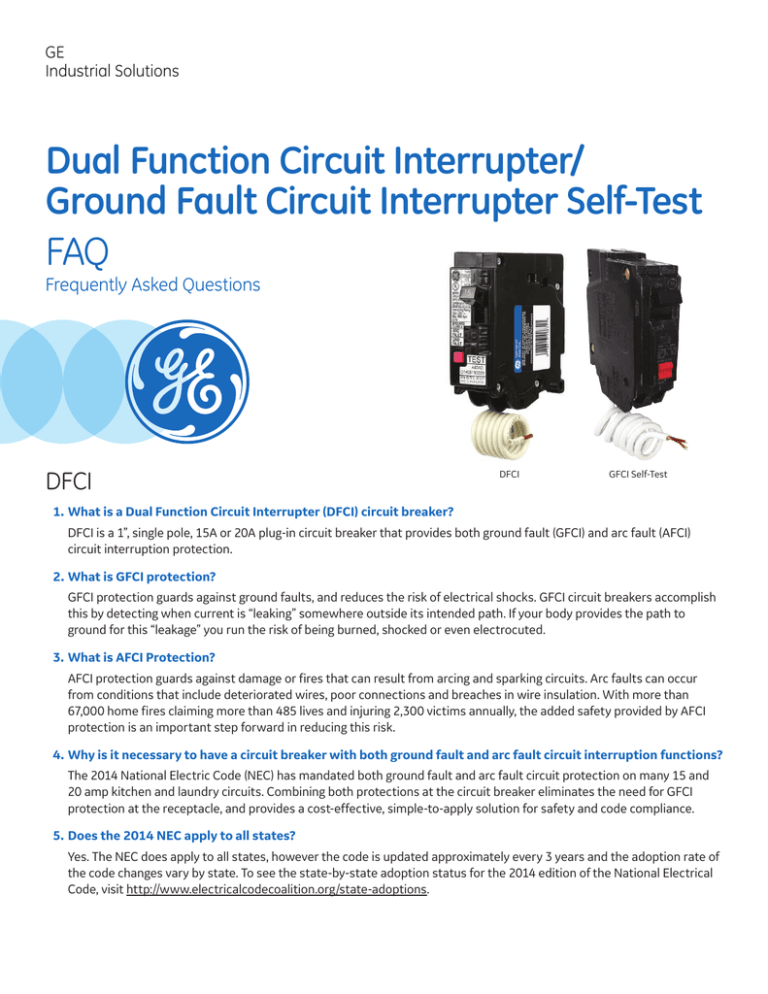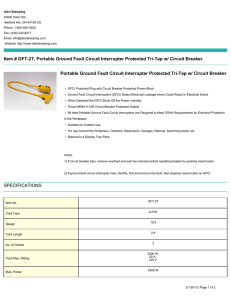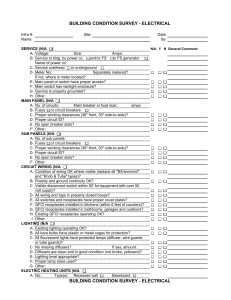
GE
Industrial Solutions
Dual Function Circuit Interrupter/
Ground Fault Circuit Interrupter Self-Test
FAQ
Frequently Asked Questions
DFCI
DFCI
GFCI Self-Test
1.What is a Dual Function Circuit Interrupter (DFCI) circuit breaker?
DFCI is a 1”, single pole, 15A or 20A plug-in circuit breaker that provides both ground fault (GFCI) and arc fault (AFCI)
circuit interruption protection.
2.What is GFCI protection?
GFCI protection guards against ground faults, and reduces the risk of electrical shocks. GFCI circuit breakers accomplish
this by detecting when current is “leaking” somewhere outside its intended path. If your body provides the path to
ground for this “leakage” you run the risk of being burned, shocked or even electrocuted.
3.What is AFCI Protection?
AFCI protection guards against damage or fires that can result from arcing and sparking circuits. Arc faults can occur
from conditions that include deteriorated wires, poor connections and breaches in wire insulation. With more than
67,000 home fires claiming more than 485 lives and injuring 2,300 victims annually, the added safety provided by AFCI
protection is an important step forward in reducing this risk.
4.Why is it necessary to have a circuit breaker with both ground fault and arc fault circuit interruption functions?
The 2014 National Electric Code (NEC) has mandated both ground fault and arc fault circuit protection on many 15 and
20 amp kitchen and laundry circuits. Combining both protections at the circuit breaker eliminates the need for GFCI
protection at the receptacle, and provides a cost-effective, simple-to-apply solution for safety and code compliance.
5.Does the 2014 NEC apply to all states?
Yes. The NEC does apply to all states, however the code is updated approximately every 3 years and the adoption rate of
the code changes vary by state. To see the state-by-state adoption status for the 2014 edition of the National Electrical
Code, visit http://www.electricalcodecoalition.org/state-adoptions.
6.Does the 2014 NEC apply to Canada?
No, this code change only impacts the U.S.
7. Is it necessary to use DFCI circuit breakers in all rooms?
No. The code mandates that all 15A and 20A outlets or devices in “dwelling units” require AFCI protection, and kitchen
and laundry areas require the additional GFCI protection. Therefore, DFCIs would typically be used in kitchen and laundry
areas, and AFCIs would be used in most of the other areas of a dwelling.
8.Does a GFCI receptacle require the use of a DFCI circuit breaker?
No, an AFCI circuit breaker may be used if there is a GFCI receptacle already providing ground fault protection. However
it is often less costly, easier to wire and troubleshoot a circuit protected by just a DFCI circuit breaker. Protecting a circuit
with a DFCI circuit breaker where both AFCI and DFCI protection are required negates the need for a GFCI receptacle.
9.Do homeowners need to retrofit their existing load centers in order to comply with the new NEC standard?
No, compliance with the new NEC standard is only required if they are replacing circuit breakers or adding new service.
10.What will happen when a DFCI circuit breaker trips?
A yellow LED will blink to indicate the last
known trip condition.
Here is how it works:
LED indicators
Last known
trip condition
Yellow 1
Yellow 2
OFF
OFF
Overcurrent
ON
OFF
Arc fault or PTT passed
ON
ON
Arc fault to ground
ON
ON
Ground fault
1. Turn the DFCI to the “ON” position.
2. Observe LED indications and compare
to the chart on the right
Arc fault
indicator
(Yellow 1)
Ground fault
indicator
(Yellow 2)
Push-to-test (PTT)
LISTED
LISTED
11.How can I clear the last known trip condition from the DFCI circuit breaker?
The last known trip condition can be cleared by the following process:
1. Turn the DFCI to the “OFF” position.
2. Press and hold the Push-To-Test (PTT) button.
3. Turn the DFCI to the “ON” position.
4. Release the PTT button after 3 seconds.
12.Can I reset a tripped DFCI circuit breaker?
Yes. However if the circuit breaker continues to trip, it is advisable that you contact an electrician to investigate this
issue. A circuit breaker will repeatedly trip when it is responding to a potentially dangerous arc fault, ground fault or
over current situation.
13.What happens when a DFCI circuit breaker will not reset?
The DFCI has a self-test feature that meets a June 2015 requirement from Underwriters Laboratory (UL) for all ground
fault circuit breakers and receptacles. This self-test feature enables the DFCI to automatically and continuously test itself
to ensure that it is working properly. If it is detected that the device has been compromised, the device trips itself into a
lockout mode. Once in the lockout mode the circuit breaker cannot be reset and must be replaced.
14.What is the kAIC rating of the DFCI circuit breaker?
The DFCI is available in 10kAIC or 22kAIC models.
15.Why will my new DFCI circuit breaker not latch when I cycle it to the "ON" position?
The DFCI must be energized in order to latch. You cannot latch the circuit breaker while handling it as you would a
traditional circuit breaker. The DFCI circuit breaker will also fail to latch if its ground fault protection becomes
compromised.
GFCI Self-Test
On, Off
Trip indicators
Push button test
validates the ground
fault detection capability
of the breaker
LISTED
LISTED
1.What is a GFCI Self-Test circuit breaker?
GFCI Self-Test is a circuit breaker that automatically runs diagnostic testing immediately after it is first switched on, and
then every 16 minutes to help ensure that the ground fault circuitry is functioning properly.
2.Don’t GFCI circuit breakers already have self-test functionality?
No, not as defined in the new UL requirements. GFCI circuit breakers have traditionally had a manual push-to-test (PTT)
button. This required users to proactively test the ground fault protection functionality at their discretion.
In comparison, the new GFCI self-test circuit breaker automatically performs this testing every 16 minutes, without the
need for human intervention, to help ensure the GFCI is functioning properly. The manual option is still included on the
new GFCI self-test circuit breaker for quick, real-time checks.
3.Why was the test function for GFCI circuit breakers changed from manual to automatic?
Self-test functionality is now a UL requirement for all GFCI devices manufactured after June 2015. This new GFCI variant
helps ensure that its ground fault circuitry is functioning properly by automatically running diagnostic testing on a
periodic basis. If a problem is detected, the circuit breaker will trip and require replacement.
4.Why did the self-test standard change?
The Consumer Product Safety Commission (CPSC) requested a change to add auto-monitoring requirements on GFCIs to
improve the reliability and safety of the devices. A National Electrical Manufacturers Association (NEMA)-led group
developed the revised standard in response to the requested change.
5.When does the new self-test standard take effect?
GFCI circuit breakers with only the push-to-test functionality can no longer be manufactured, however they may be sold
by manufacturers, retailers and distributors and used by installers until existing inventories are depleted.
(Note: This is a UL change only – the NEC is not changing. There is no requirement for self-test in the NEC and inspectors
will only require the UL listing on ground fault devices, not specifically self-test versions. GFCI circuit breakers without
self-test should not be rejected.)
6.What regions/countries are affected by this standards change?
Although the new standard does not define specific regions, the UL 943/CSA C22.2 GFCI standard primarily impacts the
U.S. and Canada. In order to maintain these certifications, manufacturers that sell GFCI circuit breakers with a UL label
into any market must comply with the new standard.
7.How will buyers know if a GE GFCI circuit breaker has the new, automatic self-test functionality?
The new GE GFCI circuit breaker part numbers will have a “T” suffix. For example, if the manual “push-to-test” GFCI part
number is THQL1120GF, the GFCI with automatic self-test number is THQL1120GFT. GE will automatically ship the new
circuit breakers as inventories of the manual test versions are phased out.
8.How does the GFCI circuit breaker with automatic self-test indicate a functional failure?
If the GFCI circuit breaker fails the automatic and periodic self-test, the LED light will illuminate and it will trip. If the
LED light illuminates again when resetting the circuit breaker, this confirms a self-test failure. The GFCI circuit breaker
will need to be replaced to prevent further tripping and to restore the GFCI protection. (Note: On 40-60amp GFCIs there
is no LED and the circuit breaker will simply not reset. This can be verified by disconnecting the load wires and
attempting to reset.)
9.When a GFCI circuit breaker trips, how can the user differentiate between a trip caused by a ground fault
versus a trip caused by a GFCI functionality failure?
An illuminated LED light indicates that the trip is the result of a self-test failure and the GFCI protection functionality is
compromised. When this happens, the circuit breaker should be replaced. If the LED light is not illuminated, the trip is
the result of a ground fault and the circuit breaker can be reset. If it continues to trip after reset, an electrician should be
consulted to troubleshoot and investigate the issue. (Note: On 40-60amp GFCIs there is no LED and the circuit breaker
will simply not reset. This can be verified by disconnecting the load wires and attempting to reset.)
10.Will the new GFCI circuit breaker with automatic self-test still have manual push-to-test (PTT) functionality?
es. In addition to the automatic self-test functionality, the manual PTT button and its manual functionality will remain
Y
on the new GFCI circuit breakers.
11.What circuits are required to have GFCI protection?
T he National Electrical Code requires Ground Fault Circuit Interrupter (GFCI) protection of receptacles located outdoors
and in kitchens, bathrooms, laundry rooms, garages and spa areas. This applies to new construction as well as existing
homes. Please refer to the National Electric Code and the local authority with jurisdiction for complete requirements.
12.What is a ground fault? Why are they dangerous?
Under normal conditions, the electrical current traveling to an electrical appliance is identical to the current traveling
from that appliance. However, an imbalance in that flow indicates a current leak — also referred to as a “ground fault,”
because the leaking current is escaping to the ground.
If the leaking current is traveling through a person, there is a risk of injury that may result in burns, a severe shock or
electrocution. For example, if a hair dryer drops into a sink full of water, some of the electrical current leaks out of the
appliance and into the water. This current leak may not be large enough to trip a non-ground fault circuit interrupter, but
could be enough to cause a fatal injury to someone who comes in contact with the water.
13.How is a GFCI circuit breaker different than a standard circuit breaker?
Standard circuit breakers only guard against over-loads and short circuits. They are not designed to protect a person
from electrical shocks. GFCI circuit breakers provide protection against overloads, short circuits and ground faults. They
detect very low levels of electrical current leakage (ground faults), and act quickly to shut off power in order to help
reduce the risk of serious shock.
14.What is the lead-time for the new GFCI self-test circuit breakers?
GFCI self-test circuit breakers will be phased in as standard manual-test GFCI circuit breakers are depleted. There will be
no change in lead times.
For more information:
www.geindustrial.com
GE
Industrial Solutions
41 Woodford Avenue
Plainville, CT 06062
www.geindustrial.com
*Indicates a trademark of the General Electric Company and/or its affiliates.
Information provided is subject to change without notice. Please verify all details with GE. All values
are design or typical values when measured under laboratory conditions, and GE makes no warranty
or guarantee, express or implied, that such performance will be obtained under end-use conditions.
©2015, General Electric Company and/or its affiliates. All rights reserved.
7.15 DEQ-230



